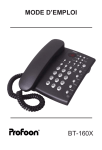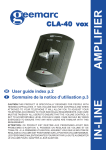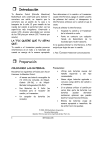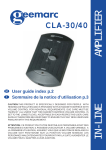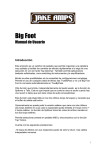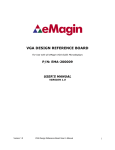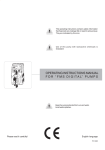Download Cadence ZRS C9 Car Amplifier User Manual
Transcript
ZRS C9 QUICK INSTALLATION GUIDE REMOTE TURN-ON FROM HEAD UNIT 80 AMP FUSE GROUND CONNECTION CABLE SHOULD USE SAME GAUGE WIRE AS POWER CABLE. KEEP GROUND CABLE AS SHORT AS POSSIBLE. ALL AMPLIFIERS IN A MULTI-AMP INSTALLATION SHOULD GROUND TO THE SAME LOCATION TO AVOID GROUND LOOPS. POWER CABLE REQUIREMENT: 4 GAUGE MINIMUM FOR 4-OHM BRIDGED OR 2-OHM STEREO HIGH POWER INSTALLS. YOU MUST INSTALL AN ADDITIONAL 80 AMP IN-LINE FUSE IN THE MAIN POWER CABLE CONNECTION. We have spared no expense in designing these amplifiers, creating the most rugged, reliable, powerful and best performing amplifiers. In fact we are so sure of the quality we backup every ZRS Series amplifier with our exclusive two-year warranty which exemplifies our commitment to excellence in car audio musical reproduction. (See enclosed warranty card for details.) Please read this installation guide carefully for proper use of your Cadence power amplifier. Should you need technical assistance during or after your installation please call our technical-line between 9:30 am and 5:00 PM EST at 732/370-5400. Read this entire guide fully before attempting your installation. WARNING: BE AWARE! Use of this amplifier at extreme high volumes for extended periods of time may cause hearing loss and or hearing damage. During periods of prolonged high volume levels it is recommended that you use ear safety devices. Playing Cadence amplifiers at high volume levels while driving will impair your ability to hear necessary traffic sounds. While driving always keep your sound volume at reasonable levels. We at Cadence want you listening for many years to come. When installing the amplifier, secure it tightly. An unmounted amplifier in your car can cause serious injury to passengers and damage to your vehicle if it is set in motion by an abrupt driving maneuver or short stop. We suggest you construct a Red wiring harness with 2 additional fuse. One fuse should be located near the car battery. This fuse near the battery offers protection against damage from short circuits to the car chassis between the battery and the amplifier. A second fuse closer to the amplifier offers additional safety to the amplifier itself. This fused red power wire should be attached to the amplifier power terminal marked 12V+. The wire harness should be made of primary cable of at least 4 gauge. The harness should terminate in a large ring terminal for connection directly to the positive terminal of the car battery. Use a spade plug to attach the wire, which connects to the amplifier location marked 12V+. ZRS Type C9 - 4 Channel High Power Amplifier 4-Ohm Power: 2-Ohm Power: 4-Ohm Bridged: IHF-2002 Peak Power: Damping Factor: Preamp Input Voltage: Low Pass Crossover: LP Crossover Slope: Band Pass Control: Subsonic HP Frequency: Bass Focus Control: Bass Equalizer: Preamp Output: Input Channels: Minimum THD: Frequency Response: Dimensions: 4 x 100 Watts RMS 4 x 150 Watts RMS 2 x 300 Watts RMS 2 x 600 Watts = 1200 Watts Max 640 @ 100Hz 200mV to 9Volt 45Hz-4.5KHz utilizing Multiplier 12db Channels 1 and 2 12db or 24dB Channels 3 and 4 Selectable Channels 3 and 4 Capable 10Hz-360Hz Flat to +7dB Flat to +12dB @ 45Hz 4 Channel Mixed Mono RCA 2 or 4 Channel Selectable <0.1% 10Hz - 40Khz +/- 3dB 9.6” x 2.32” x 15.11” (243x59x384mm) A second black color wire of equal gauge should be used as a ground connection to a welded chassis member. When connecting the ground wire make sure that there is no paint or other insulator blocking a good ground connection. When installing multiple amplifiers, mount them in close proximity so that they can all share the same ground point. Attach the black ground wire to the amplifier screw terminal marked Ground. We recommend that you use the Cadence amplifier installation kits, which contain all the cabling and accessories necessary for a good, reliable installation. Over the years we have received amplifiers back to our service department with melted power/ground terminals. The cause of this is a bad ground connection. When there is a lack of good ground, heat builds up at the weakest point which happens to be the contact screw of the amplifier terminal. Over time the heat generated will begin to melt the terminal. It is a good practice to feel the power and ground wires with your hands, near their amplifier connection after having played the amp for a while. If the wires feel hot to the touch you probably have a bad or loose connection. If you are sure of your connections and the wires still feel hot to the touch, you should upgrade the gauge of wire to next heaviest gauge. The remote turn on connection is located on the barrier strip next to the power and ground connections. This connection is responsible for turning the amplifier on and off with the rest of the system. A smaller gauge wire can be used to make this connection to your radio's power antenna lead. Should your system not have any turn on leads, you can wire the remote terminal to an accessory lead, which turns on, with your cars ignition. The ZRS Series amplifiers feature RCA preamp inputs. Run RCA cables from your sound source to the inputs of the amplifier. We suggest the use of high quality shielded RCA patch cords to help reduce and eliminate unwanted electrical noise to your system. To avoid electrical noise from being injected in to your sound systems be sure to run the RCA cables on the opposite side of the vehicle that you used to carry the power and ground leads of the amplifier. ZRS C9 To amp - 4-Ohm Single Voice Coil 4-Ohm Bridged Mono Configuration To amp + Or DVC 2-Ohm Wired in Series to 4-Ohm DVC 2-Ohm Wired in Series to 4-Ohm When bridging the ZRS C9, minimum impedance per channel is 4 ohm mono bridged. When using DVC 2 ohm woofers, voice coils must be wired in series to 4 ohm. Or 4-Ohm Single Voice Coil To amp + To amp - Midrange Midrange Tweeter 3-Channel Configuration Crossover Tweeter Crossover DVC 2-Ohm Wired in Series to 4-Ohm Channels 1 and 2 to Front Left + Front Right component speakers with channels 3 and 4 bridged to 4 ohm mono load. Or Channels 3 and 4 can be bridged to one 4-Ohm mono woofer. To amp + Two 2-Ohm woofers can be used for Stereo bass on Channels 3 and 4. To amp - 4-Ohm Single Voice Coil Midrange Tweeter 4-Channel Configuration ZRS C9 Midrange Tweeter Crossover Crossover Channels 1 and 2 to Front Left + Front Right Component Speakers. Channels 3 and 4 to Rear Left + Rear Right Component Speakers, 6” x 9” Speakers or 6.5” Speakers. Minimum Impedance 2 ohms per channel. 4-Ohm 6x9 or 6.5” Speakers Channels 3 and 4 Rear 4-Ohm Tweeters in Parallel Tweeter 4-Ohm Tweeters in Parallel Tweeter Multi-Speaker Configuration Crossover Tweeter 2-Ohm Stereo Load Tweeter Crossover 2-Ohm Stereo Load 8-Ohm Midrange 8-Ohm Midrange 8-Ohm Midrange 8-Ohm Midrange Eight 8-Ohmspeakers installed in parallel or Four 4-Ohm speakers installed in parallel. Do not mix impedances and do not run amp below 2 ohm stereo load per channel. 8-Ohm Midrange 8-Ohm Midrange 4-Ohm Midrange 8-Ohm Midrange 4-Ohm Midrange 4-Ohm Midrange 8-Ohm Midrange 4-Ohm Midrange ZRS C9 CONTROLS 2-Channel Bridged Mono Configuration - with CLONE FUNCTION. The ZRS C9 features a unique CLONE FUNCTION to assist in setting up a 2-channel bridged system with perfect gain and crossover tracking between the speakers. Typically when setting up a system you would need to set channels 1- 2 and then channels 3 - 4 crossovers and gains separately, not guaranteeing perfect balance or frequency cutoffs. By using the CLONE FUNCTION you can control channels 1 - 2 from the processed signals of channels 3 - 4 thereby guaranteeing that all 4 channels are getting identical voltages and have their crossover settings at identical frequencies. Here is how you do it. If your head unit has only one pair of RCA outputs, plug these in to channels 1 - 2 and set the mode switch to 2CH. RCA PREAMP OUTPUT If your head unit has two pairs of RCA outputs, plug these in to all 4 of the amplifiers RCA inputs and set the mode switch to 4CH. INPUT GAIN CONTROL The preamp output is a full range signal mixed from all 4 input channels. Use this signal to feed a secondary mono block amp in your system. ADJUSTABLE SUBSONIC WITH BASS FOCUS The ZRS C9 features our exclusive BASS FOCUS circuitry which works as a variable Q control at the Subsonic Filter setting. By supplying up to 7dB of boost you can compensate for drivers in too small enclosures so a 10” woofer can sound like a 12” woofer and a 12” woofer can sound like a 15” woofer. Small dash and door speakers will also benefit and will actually increase their power handling capabilities. Set the Crossover mode switch to CLONE 3/4 CH. This will send the processed signal of channels 3 and 4 to channels 1 and 2. Now all controls for channel 1 - 2 will be non functional. All crossover settings, gains, subsonic, bass focus, bass boost, frequency multipliers, and crossover slopes will be controlled from channels 3 - 4. DASH MOUNT BASS REMOTE POWER & DIAGNOSTIC LED INDICATORS The remote bass control functions on channels 3 and 4 only. When using the CLONE function, the bass remote will function on both bridged channels. Use only cable supplied with the remote for connection. All ZRS Type C amplifiers feature advanced input gain control from 0.2 volts to 9 volts so they can operate efficiently and at full power from any head unit pre amp signal. 24dB CROSSOVER SLOPE Channels 3 and 4 can be set to play Low Pass, Band Pass, High Pass or Full Range my means of the control switch. When mono bridging the amplifier you can achieve a 24dB per octave slope by setting the switch to the MONO/24dB position. For HPF/Full Range 12dB is the selectable slope. ZRS amplifiers feature sophisticated IC controlled protection circuitry. If the amp goes in to a diagnostic condition from thermal over load or speaker short circuit the LED will light and amp will shut down. CROSSOVER FREQUENCY MULTIPLIER The ZRS C9 features in both channels 1-2 and 3-4 fully adjustable crossovers. In order to make the crossover frequencies more accurate, we split the ranges from 45Hz to 450Hz and then added a 10 times (X) Frequency Multiplier switch that changes the frequency range to 450Hz-4.5KHz. This is especially useful when setting up 3 channel systems requiring a wide range of frequency settings. Before you begin with your installation, disconnect the NEGATIVE (-) terminal from your car's battery. This safety precaution will avoid possible short circuits while wiring your amplifier. Cadence amplifiers operate on 12-volt negative ground systems only. It is recommend that you layout your sound system design on paper first. This will help you during the installation so that you will have a wiring flow chart and not miss-wire any of your components. Mount the amplifier in the trunk or hatch area of your vehicle. Never install an amplifier in the engine compartment or on the firewall. Please be sure to leave breathing room around the amplifier heat sink so that it can dissipate the heat it produces efficiently. The amplifier can be installed either horizontally or vertically. When mounting the amplifier on the trunk floor, be sure to watch for your gas tank, gas lines and electrical lines. Do not drill or mount any screws where they might penetrate the gas tank of your car. Once the system is operational, the first thing to do, is set all crossover points to approximate settings. In the case of the basic sub woofer system Low Pass filter crossover at 100 Hz or so. Set the Bass Boost equalizer controls to 0 dB ( Flat Switch Position.) Now you should set the amplifiers Input Sensitivity adjustment. The knob accessible on the side of the amplifier marked INPUT GAIN adjusts the input sensitivity from 200mV to 9Volts. To adjust the input sensitivity, turn the control using a small flat head screwdriver fully counter clock wise to the minimum position. Do not apply any pressure while turning as this might break the control unit. Adjust your radio volume level to maximum volume. Now turn the level control on the amplifier clockwise towards the Maximum marking until audible distortion occurs. When you begin to hear any distortion in the sound, back down one notch and your amp is set. It is helpful to have a second person to help you set the gain. When setting up a multi-amp system, set each amplifier’s gain separately. Start off with the bass amplifier, then adjust the highs amplifier’s level control to match. Once you are satisfied with the level control settings, use any equalizer controls to adjust the system tonal level for personal preference. Keep in mind that after equalizing, you may have to go back and reset the amplifiers level controls. The level control of any car amplifier should not be mistaken for a volume control. It is a sophisticated device designed to match the output level of your source unit to the input level of the amplifier. Do not adjust the amplifier gain to maximum unless your input level requires it. If your unit has been professionally installed please do not change the gain settings set by the installer, he is the professional! Your system can also be extremely sensitive to noise when the LEVEL is set to maximum and does not match your input signal. The gain adjustments need to be made only once when first setting up the system.






